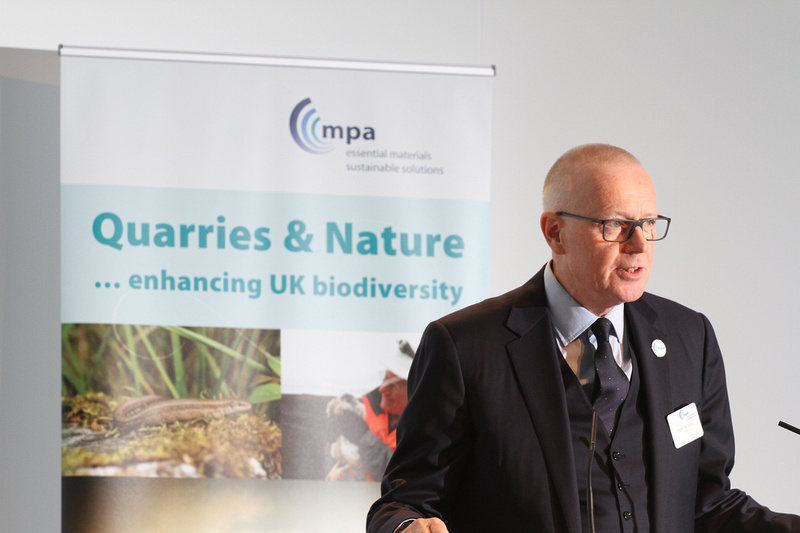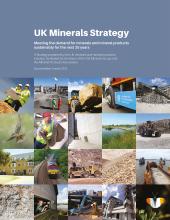
That was one of the key conclusions of the seventh joint CBI and MPA ‘Living with Minerals’ conference (LWM7) last week which stressed the need for more supportive national policy to help to create an environment for investment in UK minerals.
Three years after the launch of the UK’s ground-breaking minerals strategy at LWM6 in 2018, the online event re-visited the strategy’s three ‘pillars’ – economic, environmental and social – to assess what progress had been made and what more needs to be done.

The half-day event, attended by more than 250 delegates, included compelling presentations and thought-provoking panel sessions from speakers in the minerals industry, academia, regulators, planners and non-governmental organisations. Environmental journalist and broadcaster Sue Nelson was facilitator for the day.
Nigel Jackson, chair of the CBI Minerals Group and chief executive of the MPA, introduced the event with a reminder of the development of the UK Minerals Strategy over 20 years, stressing that it was more important than ever and should continue be used to steer policy and behaviour.
He highlighted the essentiality of minerals and how the strategy was aimed at helping decision makers ‘make the link’ between minerals, the economy and our quality of life. Minerals, he said, were often taken for granted and supply was assumed but their supply needs to be planned, monitored and managed.
Tony Danker, director general of the CBI, gave the first keynote speech, acknowledging the importance of minerals to the economy, contributing £230bn in GVA. But he said that the sector is often overlooked by politicians and the media, reiterating that a supply of minerals was assumed.
Explaining the CBI’s new Seize the Moment strategy to transform the UK economy, he added that minerals had a vital role to play, as an innovative and inclusive sector, recognised as a net zero leader and regional champion.
David Payne, MPA senior planning advisor and secretary to the CBI Minerals Group, provided an overview of the UK Minerals Strategy, pointing out early successes, including informing the National Planning Policy Framework and renewed support by government for the Managed Aggregates Supply System.
Fergus Harradence, deputy director for Construction at the Department for Business, Energy & Industrial Strategy (BEIS), outlined government initiatives for construction and how the minerals sector is a key component in their delivery. He recognised that choice of materials and construction methods was key to decarbonisation and emphasised coordination through the supply chain.
In the first panel session, ‘Planning & Regulation’ Steve Fidgett, director at Union4 Planning, considered whether the mineral planning system was still ‘up to the job’. He questioned the government’s proposed reforms, especially the ‘zonal’ approach, which would not work for minerals, concluding that the current system works reasonably well, so government should not ‘throw the baby out with the bathwater’.
Lisa Kirby-Hawkes, development manager at Hampshire County Council, gave a mineral planning authority perspective, covering the impact of a ‘climate emergency’ declaration on minerals planning and inconsistencies in new biodiversity net gain metrics, especially given the minerals sector’s long and proven track record of biodiversity enhancement.
The panel discussion identified the need for government to pay more attention to forecasting demand, including producing new national and sub-national Guidelines for aggregate provision. Concerning skills, the speakers agreed that recruitment of non-planners to minerals planning roles should be encouraged, including outreach to universities.

Session two focused on Environmental Impacts, particularly the transition to net-zero carbon. Dr Pal Chana, Executive Director of UK Concrete, introduced the UK concrete and cement industry’s ‘roadmap to beyond net zero’. Then Lee Brownsword, Industrial and Environmental Policy Manager for the British Ceramic Confederation, explained measures the sector has already taken – and was planning to take – to reduce emissions. He stressed that the transition to net-zero has to be affordable and that it will take time given the lifespan of production infrastructure.
Public Understanding and Engagement was covered by Rob Murfin, Director of Planning, Regeneration, Commercial and Economy at Northumberland County Council. He said that minerals development was considered a problem from the outset due to a poor understanding of the importance of minerals and specific agendas to prevent extraction.
He highlighted that mineral forecasts were often treated as ‘ceilings’ rather than ‘minimums’ and said that Environmental Impact Assessments (EIA) could be used positively to counter ‘pseudo-science’ in decision making and explaining how impacts would be managed and mitigated.
In the second keynote address Dr Karen Hanghøj, Director of the British Geological Survey (BGS) set out the role of the BGS, particularly providing information to underpin policy and inform decisions in the UK and elsewhere. She highlighted a new BGS assessment of UK critical raw materials, including those required for the transition to net-zero, with ‘criticality’ relating to their importance and supply risk. She concluded that BGS was all about helping society address its challenges, the solutions usually start with geology, and good data was needed for good decisions.
In the Trade and Investment panel session that followed, Barney Pilgrim, projects director of Banks Mining, highlighted that indigenous coal supply has advantages over imports, particularly greatly reduced carbon emissions from production and transport, high standards of regulation, and local economic benefits. Despite aligning with national and local policies, he described the political pressures and inconsistencies in the system that will actually inhibit the provision of sufficient local minerals, including for the transition to net-zero and ‘building back better’.
Professor Richard Herrington, head of Earth Sciences at the Natural History Museum, discussed the challenges in sourcing minerals to produce clean energy and go digital. He said that even the highest levels of recycling are insufficient to meet demand for many metals, so mining had to continue, potentially closer to home where there was better regulation, lower transport impact, and greater socio-economic benefits.
Andrew Fulton, vice president & general manager ICL-UK, ICL Boulby, and president of the Mining Association of the UK, described the mining of polyhalite, a low carbon fertiliser. He reiterated the importance of economic stability, good infrastructure, and regulatory certainty to encourage investment in minerals. The panel discussion considered the need for the transition to net-zero to include sourcing more materials indigenously and the need for better coordination of supply and regulation through a ‘Department or the value chain’.
Finally, members of the UK Minerals Forum discussed the challenges and opportunities of the new biodiversity net gain metric. This was facilitated by Dr Ian Selby, director of Sustainable Geoscience, University of Plymouth, and chair of UK Minerals Forum, with panellists Carol Reeder of Natural England, Jonathan Smith of Nottinghamshire County Council and the Planning Officers’ Society, and Nigel Symes of the RSPB and Nature After Minerals. The impressive track record of the minerals industry in delivering a gain for biodiversity was acknowledged. Also recognised was that mineral extraction is temporary land use, so the industry should not be penalised by applying the metric in the same way as for built development (as there is no separate metric for minerals specifically).










